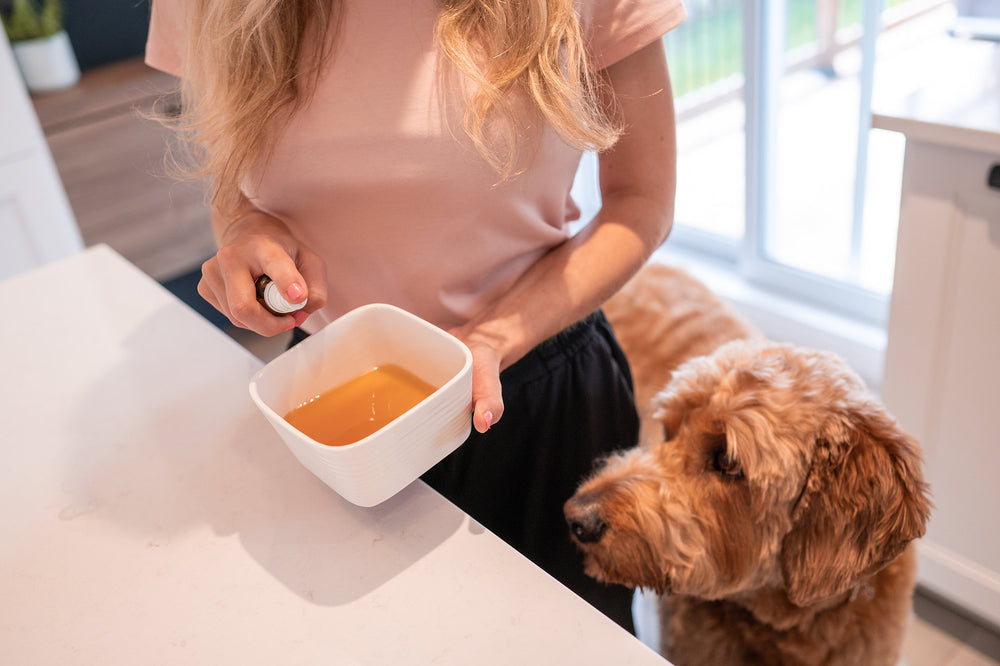2023 Canine Body Language 101
Have you ever wondered, “How do dogs communicate?” Although they can’t talk, reading dog body language is one way to get in on canine communication. Most people don't even have a clue when their dog is trying to tell them something.
Postures, expressions, and movements like a raised paw, tail wagging, and a wrinkled nose are all part of dog communication. And this involves a dog's entire body, too! When you learn how to read dog body language, you’ll also learn about your canine companion.
While there are many dog signals to keep track of, knowing them can help with training, and bonding, and can even help you avoid a dangerous altercation. Besides getting a heads up on your dog's emotional state, you'll also curb problem behavior in the process.
This is how helpful learning how to read dog body language is. Understanding your pooch is important. Being familiar with canine body language won't just help you make your pooch a happy dog but understand other dogs better as well. Try searching for a dog body language chart to use as a visual aid to help you learn!
A dog's communication is through body language signals
“We have a tendency to humanize our animals and we forget that they are not humans,” explains Kristin French of Peninsula K9 Training. “Dogs communicate in a different way that we may not realize until it's too late. I think it's important for any owner to know basic dog body language and to teach children boundaries when it comes to dogs, whether it's a dog on the street or your personal family pet.”
We asked 169 professional dog trainers from around the world for their best training tips, and they said that understanding dog body language is crucial when it comes to interacting with your canine. This guide is a compilation of some of the most common signs that every dog owner should know.
Decoding Dog Postures
 Exposed belly:
Exposed belly:
If you’ve ever seen a dog roll over, you may have assumed he was begging for a belly rub. This actually has different meanings. Interestingly, this “dog on the back” pose can also be a sign that he is afraid, or a gesture of submission or "appeasement behavior" in other dogs.
You can tell the difference by picking up on other cues: If you see a relaxed dog based on his body posture and facial expression, he probably wants to be pet. Our canine best friends usually display a neutral position when they're feeling calm and easy.
However, if the ears are flattened, the eyes are narrowed and the tail tucked between the back legs, the dog is trying to communicate that he means no harm. Your dog's behavior and body signals will also be clearly stiff.
Play bows:
Nothing says, “Let’s play!” quite as adorably as a dog bowing! When a pooch bends his front paw with his rear end in the air, possibly with a high-wagging tail, that is a clear indication that he’s ready for some fun. Other dogs smile—and similar positive facial expressions—when they're up for a game, too.
In the same way, dogs can bow repeatedly, smacking their paws on the ground to try to initiate play. Don’t be surprised if you also see a happily wagging tail! Some dogs lick their bodies and may even "fix" their hair while at it.
Raised hackles:
 Have you ever noticed a dog with a ridge of raised hair on his back—also known as his "hackles?" This is one of the most diverse body signals that you should keep an eye on when it comes to canine communication.
Have you ever noticed a dog with a ridge of raised hair on his back—also known as his "hackles?" This is one of the most diverse body signals that you should keep an eye on when it comes to canine communication.
This means he’s very alert, and he may be feeling stressed, or even aggressive. In this case, it’s best not to approach. A dog's hackles also become rather prominent when he experiences high levels of stress or sees a perceived threat, particularly in other dogs, usually with his tail held high.
Turned back:
Turning your back on someone in the human world isn’t good, but if you’ve ever asked yourself, “What does it mean when a dog turns its back on you?” You’ll be glad to know it’s a positive sign because he doesn't consider you as a perceived threat.
For starters, if a dog faces away from you, that means he doesn’t feel threatened, so he must trust you. It may also be an invitation from dogs to give their behinds a sniff. A dog may even rub one paw on you in the process. This means he isn't feeling stressed or afraid at all.
Another reason is that your clever companion learned that presenting you with his back gets him body scratches in hard-to-reach places. Dogs are pretty smart, huh?
Learning Different Dog Tail Meanings
 Tail wagging:
Tail wagging:
Does a wagging dog's tail mean "happy?" Not necessarily. Depending on how he’s wagging his tail and how his body looks, it can have the opposite meaning. Take note that head position and body language in dogs play key roles in this one, too.
Broad swooshes at mid-height usually signify the well-known "happy wag." If the movements are a bit higher and faster (and sometimes accompanied by a wiggling butt) he is very excited! This simply means that a dog is happy. A dog may also raise his head high and casually put his weight forward in this situation.
However, a high tail with rapid back-and-forth twitches likely means the dog is agitated, afraid, or highly stressed—so stay away. This could be a sign of aggressive behavior. A dog's tail down and slowly swaying means the dog is unsure, feeling a lot of stress, or wary about something.
Again, check for other body language cues to decode what the dog is saying. Keep in mind that behavior and body language should be harmonized to understand what dogs are trying to communicate.
Tail positions:
There are some non-wagging signs in dogs that have significant meanings, too.
A stiff tail that’s straight in the air signifies aggression, especially if the rest of his body is tense, his teeth are bared, and he’s leaning slightly forward as if ready to lunge. Even if dogs don’t look particularly angry, an erect one could mean that they're highly stressed or on edge and could display aggressive behavior.
The “dog tail between legs” position is a definite indicator of fear. If dogs feel threatened or cornered, they could react aggressively. This is often accompanied by a stiffly positioned head and an open mouth baring the fangs.
Deciphering Your Dog’s Eyes
 Side eye/Whale eye in dogs:
Side eye/Whale eye in dogs:
If your pooch gives you a “side eye” because you’re positioned out of the center of his vision, he may just be peering at you in his peripheral vision, so it looks like he’s giving you sass. However, a dog side eye isn’t always funny.
Sometimes, what may appear as a side eye is a dog whale eye. In this case, the whites of the eyes are more visible with the dog looking up at you as if to say, “Stay away.” (As opposed to when the dog’s eyes are relaxed, and more iris and pupil are showing.)
This expression is a canine’s way of telling you to give him some space. It’s often because he has a treat or toy that he’s feeling possessive over, but it could also be because he’s scared and doesn’t want to be approached (especially if you’re a stranger).
Dilated pupils:
Big pupils are a sure sign of arousal, whether it’s aggressive or fear-based. In either case, keep in mind that the dog isn’t feeling particularly friendly.
Staring:
 If you’ve looked up to see Fido’s eyes fixed on you and wondered “Why does my dog stare at me?" he’s just keeping an eye on you. You are the center of his world and he always wants to know what you’re doing, and of course, to make sure you’re safe.
If you’ve looked up to see Fido’s eyes fixed on you and wondered “Why does my dog stare at me?" he’s just keeping an eye on you. You are the center of his world and he always wants to know what you’re doing, and of course, to make sure you’re safe.
In a weirder scenario, you may even catch him staring at you while he’s pooping. It may seem strange to us, but it’s a vulnerable position for animals. He’s probably just making sure you’re on the lookout for any danger!
Eye contact:
Direct eye contact in the animal world is a sign of dominance and can lead to aggression. This is why it’s important to avoid prolonged eye contact, especially with pups you’ve just met — they may perceive you as a threat.
Gazing:
That being said, dogs you know well may look into your eyes with a loving gaze. As long as they’re giving off other calm, content cues (relaxed eyes and ears, happy wagging tail, etc.), they’re just trying to say “I love you”!
Winking:
You may also notice a pooch winking at you from time to time. This could be a sign of submission to break eye contact and show that he’s not a threat. Or, if it earns a positive response, a winking habit could turn into a way to get attention from you!
Explaining Other “Human” Expressions and Behaviors
 Smiling:
Smiling:
When you see a dog showing teeth in a non-aggressive way with his mouth closed and lips pulled back, he’s not beaming a grin, it’s a sign of submission. Often, dogs show this expression when they are being scolded (which is counter-productive, anyway— positive reinforcement is key!). They’re reacting to their human being upset.
However, our companions can certainly smile, in a way. When their mouths are relaxed and open and they are gently panting with their lips slightly curved up at the sides, consider it an expression of contentment.
Guilty face:
 If you’ve ever asked your pup who chewed your shoe and he immediately looked guilty or gave you a sad dog face, that expression is another sign of submission. Some dogs may even display an upturned mouth in some situations.
If you’ve ever asked your pup who chewed your shoe and he immediately looked guilty or gave you a sad dog face, that expression is another sign of submission. Some dogs may even display an upturned mouth in some situations.
Dog logic can’t grasp “I did something bad, so my human is mad,” but they will pick up that you’re not happy and respond with an action that says “You’re the boss.”
Lip Licking:
Show a pooch a juicy steak and he’ll probably start drooling and licking his chops. But canine lip-licking (when there’s no food involved) is what’s known as a “calming signal.”
The gesture is displayed to “calm” or appease the threat as if to say “I mean no harm,” and therefore, is a sign that the pooch is feeling anxious. This is how most dogs try to communicate when they want to give you the notion that you've got nothing to worry about.
Yawning:
Another calming signal, a dog yawning in the presence of stress-inducing stimuli isn’t bored or tired, he’s nervous. Our companions can yawn in a relaxed environment, just like we do! Yawns are “contagious” between humans and canines.
The next time you’re relaxing at home, try yawning near your pup and see if he “catches” one, too!
Putting It All Together: Dog Body Language Cues for Each Mood
 What does an aggressive or angry dog look like?
What does an aggressive or angry dog look like?
A canine in attack mode isn’t hard to spot but noticing subtle signs of angry/aggressive dog body language before you or your pet approaches can be different between a dangerous altercation or diffusing the situation.
There are two types of aggression, defensive and offensive. A defensive dog will defend itself in reaction to a threat, while an offensive dog will initiate the aggression.
Offensive aggression:
 This is accompanied by lots of dominant dog body language. You’ll see a dog standing up and his muscles will be rigid, often shifting his weight onto his front paws as if ready to strike. Raised hackles, bared teeth, an erect tail and ears, and unbreaking eye contact are other signals to look for.
This is accompanied by lots of dominant dog body language. You’ll see a dog standing up and his muscles will be rigid, often shifting his weight onto his front paws as if ready to strike. Raised hackles, bared teeth, an erect tail and ears, and unbreaking eye contact are other signals to look for.
Defensive aggression:
This looks slightly different, as a defensively aggressive dog will also be displaying fear. He’ll be tense, but his stance will be low to the ground with his ears flattened and his tail between his hind legs. He may also be showing his teeth, have raised hackles, and be staring directly at the human or animal approaching.
What Does a Fearful Dog Look Like?
 It’s important to pick up on fear signals, not only to calm your dog but to be aware that scared animals can become defensive and aggressive, as mentioned above.
It’s important to pick up on fear signals, not only to calm your dog but to be aware that scared animals can become defensive and aggressive, as mentioned above.
You should never approach an unknown pup displaying fear signals (and don’t let your pup get too close, either). If your companion is anxious, try to remove him from the stressor and never force an interaction between him and another human or animal.
Signs of fear:
A fearful or anxious dog will be hunched low with his tail between his hind legs. His ears will be flat against his head and his eyes may appear large and round. He may lick his lips and/or yawn, pace, or tremble. He may also raise his hackles, and in an escalated situation, may attack defensively.
What Does a Happy Dog Look Like?
 One of the reasons we love dogs is that they wear their emotions for the world to see, and when a dog is happy, there’s no mistaking it!
One of the reasons we love dogs is that they wear their emotions for the world to see, and when a dog is happy, there’s no mistaking it!
Signs of contentment:
Calm and content dogs look relaxed all over. Their ears and tails are neutral height, and they may gently wag from side to side. Their mouths are slightly open and possibly curved into a “smile,” and the pupils and irises of their eyes are showing more than the whites. They may trot to you for pets or gaze into your eyes, simply to show they care.
Signs of excitement or playfulness:
 An excited dog may wag his tail so vigorously that his butt wiggles along with it, and his mouth will be in a happy, open-mouthed “grin.”
An excited dog may wag his tail so vigorously that his butt wiggles along with it, and his mouth will be in a happy, open-mouthed “grin.”
If he wants to initiate play, he may dive into a play-bow by sinking onto his front paws with his back end straight in the air and may do this several times until you engage.
Either of these stances may be accompanied by barking, as if to say, “Come play with me!” or “I’m so happy to see you!”
There are so many signs and subtleties to learn when it comes to understanding dog language, and every dog is different—it can get confusing! That’s why it’s so important to consider context by evaluating the situation and noticing other body cues to interpret a dog’s mood.
But once you start observing, you’ll be surprised what you can learn if you know what to look for, something a professional dog trainer can help you do.
“A happy, well-balanced dog can bring joy to your life like no other thing on this earth,” says Julia Lang of Apollo Dog Training. “Dogs are capable of bringing so much into our lives, we owe it to them to give them every opportunity to live their best life.”
Did this article give you a better understanding of dog body language and why it’s so important for pet parents to learn? We hope so! If you found this information helpful, read the next article in this series, which has professional tips on dealing with the most difficult dog behavior of all: aggression.
You can also communicate with certified pet homeopathy experts while you're at it.






Leave a comment